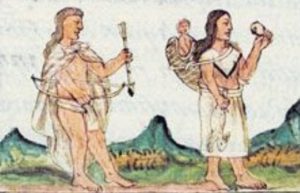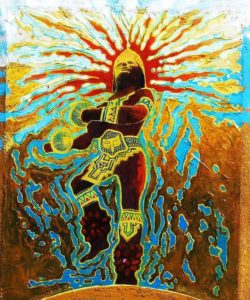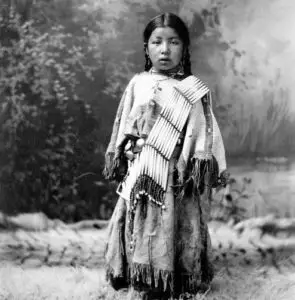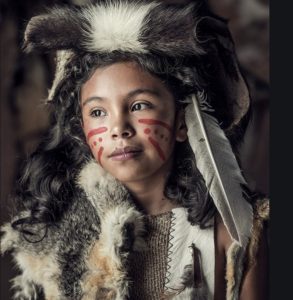Podcast: Play in new window | Download
Subscribe: Apple Podcasts | RSS
 On many old maps of Mexico there are large areas of land to the north of the Spanish colonies in the former Aztec lands of central Mexico with a sweeping label: La Gran Chichimeca. In the language of the Aztecs, Nahuatl, the words chichimeca or chichimécatl mean, “the inhabitants of the land of Chichiman.” The word “Chichiman” translates to “The Land of Milk,” in English. The Aztecs used this term to describe the modern-day Mexican bajio region located on the northern fringes of their empire and beyond. This area had very few permanent settlements and consisted of rugged mountains and stark deserts. The inhabitants of this largely unexplored and unknown territory were called collectively “Chichimeca” by the Aztecs. The word Chichimeca would soon be associated with the terms, “barbarian” or “uncivilized,” in the Aztec language and later the same with the Spanish. For more information about the Chichimecs please see Mexico Unexplained episode number 142 https://mexicounexplained.com///chichimeca-warriors-of-the-north/ but for now, here are three legends from Chichimeca folklore.
On many old maps of Mexico there are large areas of land to the north of the Spanish colonies in the former Aztec lands of central Mexico with a sweeping label: La Gran Chichimeca. In the language of the Aztecs, Nahuatl, the words chichimeca or chichimécatl mean, “the inhabitants of the land of Chichiman.” The word “Chichiman” translates to “The Land of Milk,” in English. The Aztecs used this term to describe the modern-day Mexican bajio region located on the northern fringes of their empire and beyond. This area had very few permanent settlements and consisted of rugged mountains and stark deserts. The inhabitants of this largely unexplored and unknown territory were called collectively “Chichimeca” by the Aztecs. The word Chichimeca would soon be associated with the terms, “barbarian” or “uncivilized,” in the Aztec language and later the same with the Spanish. For more information about the Chichimecs please see Mexico Unexplained episode number 142 https://mexicounexplained.com///chichimeca-warriors-of-the-north/ but for now, here are three legends from Chichimeca folklore.
- The Holy Man and the Hill of Death
In the southern part of the Sierra Madre Occidental a small group of young Chichimec men decided to visit a local hot springs. They were accompanied by a tribal elder, a holy man who liked to go to the healing waters of the springs at least once a year. The holy man, although much older than the young warriors, was tall and stocky and had a majestic and imposing appearance. Near the end of the day, at dusk, the holy man went underneath the water of one of the many pools at the springs and never resurfaced. The young men were not paying attention and when they did not see their esteemed friend after some time they checked the ponds to see if he had drowned. After failing to find his body, they assumed that the holy man had been taken away by the Chalcas, an indigenous group from the Valley of Mexico that was in a constant state of off-and-on war with the Chichimecas. The young men returned to their encampments and told the Chichimec leaders that they had suspected the Chalcas had abducted their venerated elder. The leaders spread the word throughout the territory to prepare for war against the Chalcas.
 The next day, the Chichimecs brought the fight to their enemies, the Chalcas. As a more sedentary and supposedly civilized society the Chalcas were considered more advanced than the northern warrior tribes. Even though the Chichimecas were outnumbered, they fought valiantly to avenge the death of their beloved holy man. In the middle of one of the fiercest battles, with obsidian-tipped Chichimeca arrows cutting through the ranks of the more disciplined Chalca military, the holy man suddenly appeared. It was unclear if the Chalcas had actually captured him the day before and let him go, or if he just happened upon the battle. In any case, he was killed almost instantly. His body fell on top of other dead Chichimec warriors and the earth around them started to turn red. Before everyone’s eyes, the small mound of bodies turned into a gigantic hill. To this day the locals in the area call the miniature mountain Cerro del Muerto, or Hill of Death. People claim there are endless tunnels that go through the hill and many have fallen to their deaths in the hill’s supposedly bottomless caverns. Some believe that the tunnels and caves are not natural and were made by hand by the members of a long-forgotten people or an alien race.
The next day, the Chichimecs brought the fight to their enemies, the Chalcas. As a more sedentary and supposedly civilized society the Chalcas were considered more advanced than the northern warrior tribes. Even though the Chichimecas were outnumbered, they fought valiantly to avenge the death of their beloved holy man. In the middle of one of the fiercest battles, with obsidian-tipped Chichimeca arrows cutting through the ranks of the more disciplined Chalca military, the holy man suddenly appeared. It was unclear if the Chalcas had actually captured him the day before and let him go, or if he just happened upon the battle. In any case, he was killed almost instantly. His body fell on top of other dead Chichimec warriors and the earth around them started to turn red. Before everyone’s eyes, the small mound of bodies turned into a gigantic hill. To this day the locals in the area call the miniature mountain Cerro del Muerto, or Hill of Death. People claim there are endless tunnels that go through the hill and many have fallen to their deaths in the hill’s supposedly bottomless caverns. Some believe that the tunnels and caves are not natural and were made by hand by the members of a long-forgotten people or an alien race.
- The Blind God and the Young Girl
Before the city of Aguascalientes was founded by the Spanish in 1575 a small Chichimec village existed on the present townsite. The people were semi-nomadic and used the village as a base for their hunting and gathering, and sometimes grew crops. The people there engaged in trade with other local tribes. A prominent Chichimeca family lived in this village year-round in a small hut near the current Jardín de Zaragoza, Aguascalientes. The young married couple had a nine-year-old daughter; the girl was very pretty and of very good character. They considered themselves a very religious family and while the parents worshiped the god of the markets, the girl was devoted to Chulinche, a blind god who was responsible for certain aspects of nature. Everyone was very happy until the parents died. For months the girl lived in a fog of depression and the deaths took a toll on her. Although she was able to survive with support of the village and her extended family, after a while, Chulinche, the god she worshiped sent a spirit to watch over her.
The girl grew into a somewhat frivolous and flirtatious young woman. She would lie and steal and had a bad reputation throughout Chichimec territory. For these reasons, Chulinche appeared to the girl and asked her what her ambitions were. The god explained that whatever she wanted would be granted to her until the day of her death. The young woman’s thoughts were all over the place. She raved when she talked and even the god Chulinche thought she was a little crazy. He took pity on her because for most of her life the girl had to fend for herself and lacked guidance. So, Chulinche asked the other gods to help him make the girl’s life better. They agreed to help her, but under the conditions that she would become a mother to many children and would eventually populate the entire territory where she lived. Chulinche thought it was a good bargain, but the young woman still had a long way to go before she was remotely capable of having a family.
 The young woman was told of this bargain to help her and of her destiny to be a mother of a whole village of children. She wanted to start right away and prayed to Chulinche at a small shrine she made in her hut. Chulinche warned her that it was not yet the right time to populate the region, to which the beautiful young woman replied that the sooner she fulfilled what was requested by the gods, the better. The god again told her to wait, but the young woman was not waiting for a husband to help her with her destiny. She consulted with a shaman in the village who told her that she could make her babies out of clay and breathe life into them. She told Chulinche that she wanted to start making babies the way the shaman had instructed her. When the blind god gave her his permission, the young woman began to make clay dolls that she distributed throughout the countryside and gave them life with her breath. The human beings created by the girl loved her very much because she was very kind to them. They believed her to be a goddess, to whom they offered honey and milk. When she died, they offered her prayers and fasts and as a form of devotion they stuck maguey thorns in their knees. Today in the modern city of Aguascalientes, the people have dedicated a small side street to this young woman located at the end of Calle Juárez called Calle Indita.
The young woman was told of this bargain to help her and of her destiny to be a mother of a whole village of children. She wanted to start right away and prayed to Chulinche at a small shrine she made in her hut. Chulinche warned her that it was not yet the right time to populate the region, to which the beautiful young woman replied that the sooner she fulfilled what was requested by the gods, the better. The god again told her to wait, but the young woman was not waiting for a husband to help her with her destiny. She consulted with a shaman in the village who told her that she could make her babies out of clay and breathe life into them. She told Chulinche that she wanted to start making babies the way the shaman had instructed her. When the blind god gave her his permission, the young woman began to make clay dolls that she distributed throughout the countryside and gave them life with her breath. The human beings created by the girl loved her very much because she was very kind to them. They believed her to be a goddess, to whom they offered honey and milk. When she died, they offered her prayers and fasts and as a form of devotion they stuck maguey thorns in their knees. Today in the modern city of Aguascalientes, the people have dedicated a small side street to this young woman located at the end of Calle Juárez called Calle Indita.
- Chichimec Giants
A few hundred thousand years ago, back in the dawn of life when the earth was just beginning to cool and the rains were torrential, the footsteps of giants who were the masters and lords of all resonated firmly on the surface of this world. The intelligence of this race surpassed the level of any other creature in the Animal Kingdom. Their features were so fine and aristocratic, and their athletic, well-proportioned bodies were unmatched in the universe.
They built huge cities and their palaces have not even been dreamed of by modern man because they combined the beautiful with the practical and the comfortable with the safe. All the old ruins of ancient Mexico were made by these giants.
Along with the land, which gave them abundant crops, the race of giants cultivated the Fine Arts, because their civilization was very advanced. So wonderful was their way of life that many still do not believe they ever existed. War and hatred were absent from their souls. Never, as then, was peace so fraternal and lasting on earth. Thus, they lived countless centuries: Loving everything that surrounded them. Nature, always lavish, gave them everything and they lived in harmony with nature. However, not even that true blissful earthly paradise was eternal. The day came when everything ended in a geological cataclysm. Intense tremors shook the earth in convulsions of death; destroying entire cities with their inhabitants in their wake.
At last, peace and stability returned, but the world of the giants was almost totally obliterated and its remaining population frightened that something similar would happen again.
Among the few survivors there was a young couple: Verlé, the prince of the northern country whose name means “Hot Springs,” and Kirle the princess of the great southern city whose name means “Crystal Waters.”
 They were the chosen ones to go talk to the head of the gods. After a great deal of preparation, they came to his presence, but the chief god already knew why they had come before him. Despite the utter destruction of their lands, the remaining giants wanted to stay and rebuild. The old god told them that they would have to emigrate to other lands because the catastrophe that just happened to them could happen again and there would be no sense in building their cities once more. The giant prince and princess did not want to defy the deity and begged for his permission to stay in their lands. The god eventually said yes, but under one condition, that it must be for eternity.
They were the chosen ones to go talk to the head of the gods. After a great deal of preparation, they came to his presence, but the chief god already knew why they had come before him. Despite the utter destruction of their lands, the remaining giants wanted to stay and rebuild. The old god told them that they would have to emigrate to other lands because the catastrophe that just happened to them could happen again and there would be no sense in building their cities once more. The giant prince and princess did not want to defy the deity and begged for his permission to stay in their lands. The god eventually said yes, but under one condition, that it must be for eternity.
When Prince Verlé and Princess Kirle returned to their lands, they notified the few who remained of their decision. Verlé, or “Hot Springs” lay down on the land he loved so much, his head to the South. Kirle, or “Crystal Waters” placed her head in front of the prince’s and leaned her body slightly towards the Southwest. In the distance, the rest of that race of giants took the positions that best suited them, to wait for eternity.
Four of the bravest knights of the giants called: Galfo, or “Good Land”; Talt, or “Clear Water”; Kilse, or “Clear Sky”; and Máchi, or “Good People”; dropped to one knee and bowed their heads to await the end.
At that time, a long eclipse began to darken the earth, and when seven hours later the sun reappeared, a living being was nowhere to be seen. The giants were transformed into enormous hills, among which the figures of the warrior knights stood out, seen from the foothills of the Sierra de Guajolotes, at the point that is precisely above the town that is know today Pedregal Primero, on the road that leads to Calvillo.
From the city of Aguascalientes, only the recumbent figure of Verlé can be seen, who is currently known as the Cerro del Picacho.
The four knights of the giants also stand out. To the south, the Cerro de Los Gallos, which was known as the giant named Talt. To the north, the Cerro de San Juan, in the mountainous massif of Tepezalá, was the giant known as Kilse. One kilometer ahead, the Cerro de Altamira that was once Máchi. Further towards the west lies the esteemed giant Galfo, which is now Cerro del Laurel, close to the town of Calvillo.
To the Chichimeca, those giants never died. They watch over the lives of the people who have inherited their spirituality, their love for family, and their eternal adoration of the land.
REFERENCES
Thanks to the Para Todo Mexico site for their endless legends.

One thought on “Legends of the Chichimeca”
Los descendientes de los Chichimecas tenemos que conocer nuestras leyendas para conocernos en el mas hondo del existir y enfrentarnos al mundo technologico que causa ansiedad y negativo con mejor base espirito y conciencia. Gracias por tu dedicación a esto.